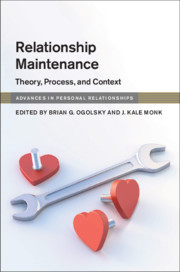Book contents
- Relationship Maintenance
- Advances in Personal Relationships
- Relationship Maintenance
- Copyright page
- Contents
- Tables
- Figures
- Contributors
- Part I Introduction
- Part II Theories of Relationship Maintenance
- Part III Processes of Relationship Maintenance
- 7 Communication and Relationship Maintenance
- 8 Attributions, Forgiveness, and Gratitude as Relationship Maintenance Processes
- 9 Social Networks and Relationship Maintenance
- 10 Dyadic Coping as Relationship Maintenance
- 11 Conflict Management and Problem Solving as Relationship Maintenance
- 12 Sex as Relationship Maintenance
- 13 Accuracy and Bias in Relationship Maintenance
- Part IV The Social Context of Relationship Maintenance
- Part V Conclusion
- Index
- References
12 - Sex as Relationship Maintenance
from Part III - Processes of Relationship Maintenance
Published online by Cambridge University Press: 02 December 2019
- Relationship Maintenance
- Advances in Personal Relationships
- Relationship Maintenance
- Copyright page
- Contents
- Tables
- Figures
- Contributors
- Part I Introduction
- Part II Theories of Relationship Maintenance
- Part III Processes of Relationship Maintenance
- 7 Communication and Relationship Maintenance
- 8 Attributions, Forgiveness, and Gratitude as Relationship Maintenance Processes
- 9 Social Networks and Relationship Maintenance
- 10 Dyadic Coping as Relationship Maintenance
- 11 Conflict Management and Problem Solving as Relationship Maintenance
- 12 Sex as Relationship Maintenance
- 13 Accuracy and Bias in Relationship Maintenance
- Part IV The Social Context of Relationship Maintenance
- Part V Conclusion
- Index
- References
Summary
Sex is a powerful way for couples to enhance their bond and promote the success and happiness of their relationship. Yet, maintaining sexual intimacy and passion is a challenging endeavor in romantic relationships, making it crucial to understand the role of sex in relationship maintenance. This chapter focuses on the role of sexuality in enabling couples to maintain satisfying relationships, focusing in particular on how couples can maintain sexual desire and satisfaction over time and as they navigate important relationship and life changes that may result in partners experiencing differences in their sexual interests, such as in the transition to parenthood. We begin the chapter by describing the ways that sex can benefit relationships, focusing on the roles of sexual frequency, physical affection, and sexual satisfaction in shaping the quality and maintenance of relationships. Then, we review research on how couples can prevent declines in sexual desire, or remain satisfied in spite of these declines, with a particular focus on sexual goals, sexual communal motivation, sexual communication, and sexual expectations. We conclude the chapter by highlighting several promising directions for future research on sex and relationship maintenance.
- Type
- Chapter
- Information
- Relationship MaintenanceTheory, Process, and Context, pp. 215 - 239Publisher: Cambridge University PressPrint publication year: 2019
References
- 1
- Cited by



